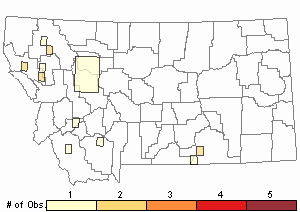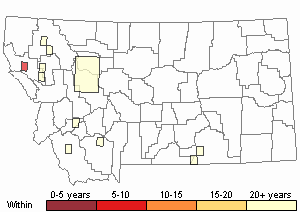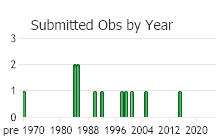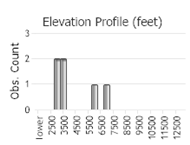View in other NatureServe Network Field Guides
NatureServe
Montana
Utah
Wyoming
Idaho
Wisconsin
British Columbia
South Carolina
Yukon
California
New York
Panic Grass - Dichanthelium acuminatum
Other Names:
Panicum acuminatum, Dichanthelium lanuginosum, Panicum lanuginosum, Panicum occidentale
State Rank Reason (see State Rank above)
Dichanthelium acuminatum is common and ubiquitous in most of the U.S. and Canada (Freckmann and Lelong in FNA 2007). The species is polymorphic and 10 major subspecies have been described, but many overlap in characteristics and widespread introgression from other Dichanthium species contributes to taxonomic difficulties (Freckmann and Lelong in FNA 2007). However, only subspecies sericeum has been documented in Montana. Dichanthelium acuminatum susp. sericeum colonizes wet soils around the edges of hot springs. It occurs widely scattered through south-central, southwest, and northwest Montana, where it can be locally common. Observation data is aging, and some re-visits to known populations did not re-locate the grass. Given its narrow habitat requirements, potential threats from ground disturbance and recreation, and lack of current data a Species of Concern rank is warranted. Current data on locations, population sizes, threats, and how it responds to natural and manmade disturbances are greatly needed.
- Details on Status Ranking and Review
Range Extent
ScoreF - 20,000-200,000 sq km (~8,000-80,000 sq mi)
Comment87,421 square kilometers
Area of Occupancy
ScoreD - 6-25 4-km2 grid cells
CommentPlant occurs in 16 of the 30,590 4x4 square-kilometer grid cells that cover Montana.
Number of Populations
ScoreB - 6 - 20
Comment17 observations representing 16 distinct occurrences. Adjacent occurrences in YNP-WY are also present.
Environmental Specificity
ScoreA - Very narrow. Specialist or community with key requirements scarce
CommentWet soil around hot springs, which represent limited and/or fragile habitat.
General Description
PLANTS: Cool season, bunched, perennial grass, 10-30 cm tall. Plants have a large showy, dark panicle which greatly exceeds the cauline leaves at reproductive maturity.
LEAVES: Basal and cauline alike, generally 5 to 10 mm wide. The 4-7 cauline leaves have a hairy ligule, 2-6 mm long. Fall shoots arising from all but the upper nodes. Vegetative leaves can form rosettes.
INFLORESCENCE: A diffuse, open panicle. The panicle may appear dark due to the second glume becoming purplish at maturity. Spikelets 1.5–2 mm long with 1 fertile floret. Glumes hairy and unequal in length. First glume 0.5–0.75 mm long and second glume 1.5–2 mm long. Lemmas are blunt, globe-like. Palea is enclosed in the floret.
Montana plants are subspecies sericeum (Lesica et al. 2012).
Sources: Lesica et al. 2012; Freckman & Lelong in FNA 2007; Flora of the Great Plains (1986).
Diagnostic Characteristics
Dichanthelium has been segregated from
Panicum. Montana has 3 species of
Dichanthelium. Members of
Dichanthelium:
* Develop a rosette of short, broad basal leaves during the cool season, while
Panicum species do not.
* Grow during the cool and warm seasons, whereas,
Panicum species grow in the warm season.
* Produce cleistogamous (self-pollinating) florets, which are often found on small axillary inflorescences during the late summer to fall.
Panic Grass –
Dichanthelium acuminatum subsp.
sericeum, native, SOC
* Stems 10-30 cm tall.
* Spikelets 1.5-2.5 mm long.
* At maturity the larger second glume is often purplish.
* Upper and lower leaf surfaces hairy.
* Ligules 2-6 tall.
*
Often in wet soils around hot springs.
Wilcox’s Panic Grass –
Dichanthelium wilcoxianum, native
* Stems 10-20 cm tall.
* Spikelets less than 2.5 mm long.
* Upper and lower leaf surfaces hairy.
* Ligules 1.0 mm or less tall.
* Grasslands and open Ponderosa Pine forests in eastern Montana.
Scribner’s Panic Grass –
Dichanthelium oligosanthes var.
scribnerianum, native, SOC
* Stems 20-50 cm tall.
* Spikelets 2-5 mm long.
* Upper leaf surface is glabrous. Lower leaf surface is hairy.
* Ligules 1-3 mm tall.
* Disturbed sites and open understory in northwest and southeast Montana.
Switchgrass (
Pancium virgatum) is a rhizomatous, perennial grass while Montana's other
Panicum species are annuals.
Species Range
Montana Range
Range Descriptions

 Native
Native
Range Comments
Throughout most of North America; subspecies sericeum is more narrowly confined to the U.S. in the Rocky Mountain states, UT, CO, WY, ID and MT (Lesica et al. 2012).
Observations in Montana Natural Heritage Program Database
Number of Observations: 15
(Click on the following maps and charts to see full sized version)
Map Help and Descriptions
Relative Density

Recency



 (Observations spanning multiple months or years are excluded from time charts)
(Observations spanning multiple months or years are excluded from time charts)
Habitat
Often forming dense stands on wet soils around edges of hot springs (Lesica et al. 2012).
National Vegetation Classification System Groups Associated with this Species
Wetland and Riparian
Wet Meadow and Marsh
Reproductive Characteristics
This grass can produce panicles in both the late spring to early summer and the mid-summer to fall periods (Lesica et al. 2012; Flora of the Great Plains 1986). Early flowering plants may exhibit both self-pollinating and cross-pollinating florets. Late flowering plants may have panicle branches clustered among the leaves and are composed of self-pollinating florets.
Stewardship Responsibility
Threats or Limiting Factors
STATE THREAT SCORE REASON
Reported threats to Montana's populations of Tapered Rosette Grass (Dichanthelium acuminatum subsp. sericeum) are currently assigned as unknown. Potential threats of ground disturbance and recreation need to be substantiated before a threat rank can be assigned (MTNHP Threat Assessment 2021).
References
- Literature Cited AboveLegend:
 View Online Publication
View Online Publication Flora of North America Editorial Committee. 2003. Flora of North America North of Mexico. Vol. 25. Magnoliophyta: Commelinidae (in part): Poaceae, part 2. Oxford Univ. Press, New York. xxv + 781 pp.
Flora of North America Editorial Committee. 2003. Flora of North America North of Mexico. Vol. 25. Magnoliophyta: Commelinidae (in part): Poaceae, part 2. Oxford Univ. Press, New York. xxv + 781 pp. Lesica, P., M.T. Lavin, and P.F. Stickney. 2012. Manual of Montana Vascular Plants. Fort Worth, TX: BRIT Press. viii + 771 p.
Lesica, P., M.T. Lavin, and P.F. Stickney. 2012. Manual of Montana Vascular Plants. Fort Worth, TX: BRIT Press. viii + 771 p. MTNHP Threat Assessment. 2021. State Threat Score Assignment and Assessment of Reported Threats from 2006 to 2021 for State-listed Vascular Plants. Botany Program, Montana Natural Heritage Program, Helena, Montana.
MTNHP Threat Assessment. 2021. State Threat Score Assignment and Assessment of Reported Threats from 2006 to 2021 for State-listed Vascular Plants. Botany Program, Montana Natural Heritage Program, Helena, Montana.
- Additional ReferencesLegend:
 View Online Publication
View Online Publication
Do you know of a citation we're missing? Lesica, P., M.T. Lavin, and P.F. Stickney. 2022. Manual of Montana Vascular Plants, Second Edition. Fort Worth, TX: BRIT Press. viii + 779 p.
Lesica, P., M.T. Lavin, and P.F. Stickney. 2022. Manual of Montana Vascular Plants, Second Edition. Fort Worth, TX: BRIT Press. viii + 779 p. McGregor, R.L. (coordinator), T.M. Barkley, R.E. Brooks, and E.K. Schofield (eds). 1986. Flora of the Great Plains: Great Plains Flora Association. Lawrence, KS: Univ. Press Kansas. 1392 pp.
McGregor, R.L. (coordinator), T.M. Barkley, R.E. Brooks, and E.K. Schofield (eds). 1986. Flora of the Great Plains: Great Plains Flora Association. Lawrence, KS: Univ. Press Kansas. 1392 pp.
- Web Search Engines for Articles on "Panic Grass"





